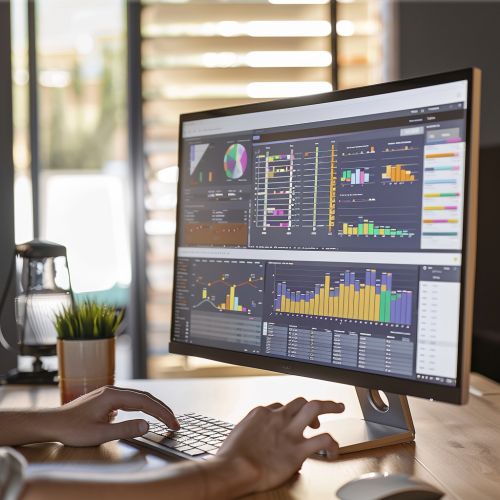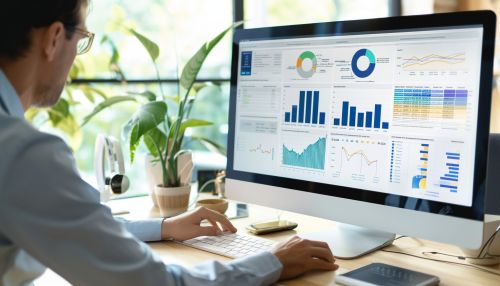Data Visualization Tools
Introduction
Data visualization tools are software applications designed to help users create graphical representations of data. These tools are essential in the fields of data science, business intelligence, and statistics, among others. They enable users to understand complex data sets by transforming them into visual formats such as charts, graphs, and maps. This article delves deeply into various data visualization tools, their features, applications, and the underlying technologies that power them.
Types of Data Visualization Tools
Data visualization tools can be broadly categorized into several types based on their functionality and use cases:
General-Purpose Tools
General-purpose data visualization tools are versatile and can be used across various domains. They offer a wide range of visualization options and are suitable for both beginners and experts.
- **Tableau**: Known for its user-friendly interface and powerful data processing capabilities, Tableau allows users to create complex visualizations with ease. It supports a wide range of data sources and offers features like drag-and-drop functionality, real-time data analysis, and interactive dashboards.
- **Microsoft Power BI**: This tool integrates seamlessly with other Microsoft products and offers robust data visualization capabilities. Power BI supports real-time data streaming, custom visualizations, and advanced analytics.
- **QlikView**: QlikView provides associative data indexing, which allows users to explore data in a non-linear fashion. It supports a wide range of data sources and offers features like dynamic dashboards and real-time analytics.
Specialized Tools
Specialized data visualization tools are designed for specific industries or types of data.
- **Gephi**: Gephi is an open-source network analysis and visualization software. It is particularly useful for visualizing complex networks and graphs. Gephi offers features like dynamic filtering, clustering, and real-time visualization.
- **D3.js**: D3.js is a JavaScript library for producing dynamic, interactive data visualizations in web browsers. It leverages web standards such as SVG, HTML5, and CSS. D3.js is highly customizable and is often used for creating bespoke visualizations.
- **Plotly**: Plotly is a graphing library that supports a wide range of chart types, including 3D charts and statistical graphs. It is particularly popular in the scientific community for its ability to handle large datasets and its integration with programming languages like Python and R.
Key Features of Data Visualization Tools
Data visualization tools come with a variety of features that enhance their functionality and usability. Some of the key features include:
Interactivity
Interactivity is a crucial feature that allows users to engage with the data. Interactive elements such as tooltips, zooming, and filtering enable users to explore data in depth.
Real-Time Data Processing
Many modern data visualization tools support real-time data processing, allowing users to visualize data as it is generated. This is particularly useful in applications like financial trading and network monitoring.
Customizability
Customizability refers to the ability to tailor visualizations to meet specific needs. This includes customizing the appearance of charts, adding custom labels, and integrating with other software applications.
Scalability
Scalability is the ability of a tool to handle large datasets efficiently. Tools like Tableau and Power BI are designed to scale with the size of the data, ensuring that performance remains optimal even with large volumes of data.
Integration with Data Sources
Data visualization tools often support integration with a wide range of data sources, including databases, cloud services, and APIs. This allows users to pull data from multiple sources and create comprehensive visualizations.
Applications of Data Visualization Tools
Data visualization tools are used in a variety of applications across different industries:
Business Intelligence
In business intelligence, data visualization tools are used to create dashboards and reports that provide insights into business performance. These tools help organizations make data-driven decisions by presenting key metrics in an easily understandable format.
Healthcare
In healthcare, data visualization tools are used to analyze patient data, track disease outbreaks, and monitor public health trends. Visualizations can help identify patterns and correlations that might not be apparent in raw data.
Scientific Research
In scientific research, data visualization tools are used to analyze experimental data, visualize complex simulations, and present findings in a clear and concise manner. Tools like Plotly and D3.js are particularly popular in this field.
Marketing
In marketing, data visualization tools are used to analyze customer behavior, track campaign performance, and visualize market trends. These tools help marketers understand their audience and optimize their strategies.
Underlying Technologies
The technologies that power data visualization tools are diverse and constantly evolving. Some of the key technologies include:
Data Processing Engines
Data processing engines like Apache Spark and Hadoop are used to process large datasets efficiently. These engines support parallel processing and distributed computing, making them ideal for handling big data.
Visualization Libraries
Visualization libraries like D3.js, Plotly, and Chart.js provide the building blocks for creating custom visualizations. These libraries offer a wide range of chart types and customization options.
Machine Learning and AI
Machine learning and AI technologies are increasingly being integrated into data visualization tools. These technologies can help identify patterns and trends in data, automate the creation of visualizations, and provide predictive analytics.
Cloud Computing
Cloud computing platforms like Amazon Web Services, Microsoft Azure, and Google Cloud Platform provide the infrastructure needed to store and process large datasets. Many data visualization tools offer cloud-based solutions that allow users to access their data and visualizations from anywhere.
Challenges and Limitations
While data visualization tools offer numerous benefits, they also come with certain challenges and limitations:
Data Quality
The quality of the data being visualized is crucial. Poor data quality can lead to misleading visualizations and incorrect conclusions. Ensuring data accuracy and completeness is a significant challenge.
Complexity
Creating effective visualizations often requires a deep understanding of both the data and the visualization techniques. This can be a barrier for users who lack the necessary expertise.
Performance
Handling large datasets can be resource-intensive, and performance can be a concern. Ensuring that visualizations remain responsive and interactive, even with large volumes of data, is a key challenge.
Cost
Many advanced data visualization tools come with significant costs, which can be a barrier for small organizations or individual users. Open-source alternatives are available, but they may lack some of the features and support offered by commercial tools.
Future Trends
The field of data visualization is rapidly evolving, with several trends shaping its future:
Augmented Analytics
Augmented analytics leverages AI and machine learning to automate data preparation, insight generation, and visualization. This trend is expected to make data visualization more accessible and reduce the reliance on specialized skills.
Virtual Reality (VR) and Augmented Reality (AR)
VR and AR technologies are being explored for data visualization, offering immersive and interactive ways to explore data. These technologies have the potential to revolutionize how we interact with and understand complex data sets.
Natural Language Processing (NLP)
NLP is being integrated into data visualization tools to enable users to interact with their data using natural language queries. This can make data exploration more intuitive and accessible.
Increased Focus on Data Ethics
As data visualization becomes more prevalent, there is an increasing focus on data ethics. Ensuring that visualizations are accurate, unbiased, and ethically sound is becoming a priority.
Conclusion
Data visualization tools play a crucial role in transforming raw data into meaningful insights. They are used across various industries and applications, offering features like interactivity, real-time data processing, and customizability. While there are challenges and limitations, the future of data visualization looks promising with trends like augmented analytics, VR/AR, and NLP shaping the field. Understanding and leveraging these tools can significantly enhance data-driven decision-making and communication.


